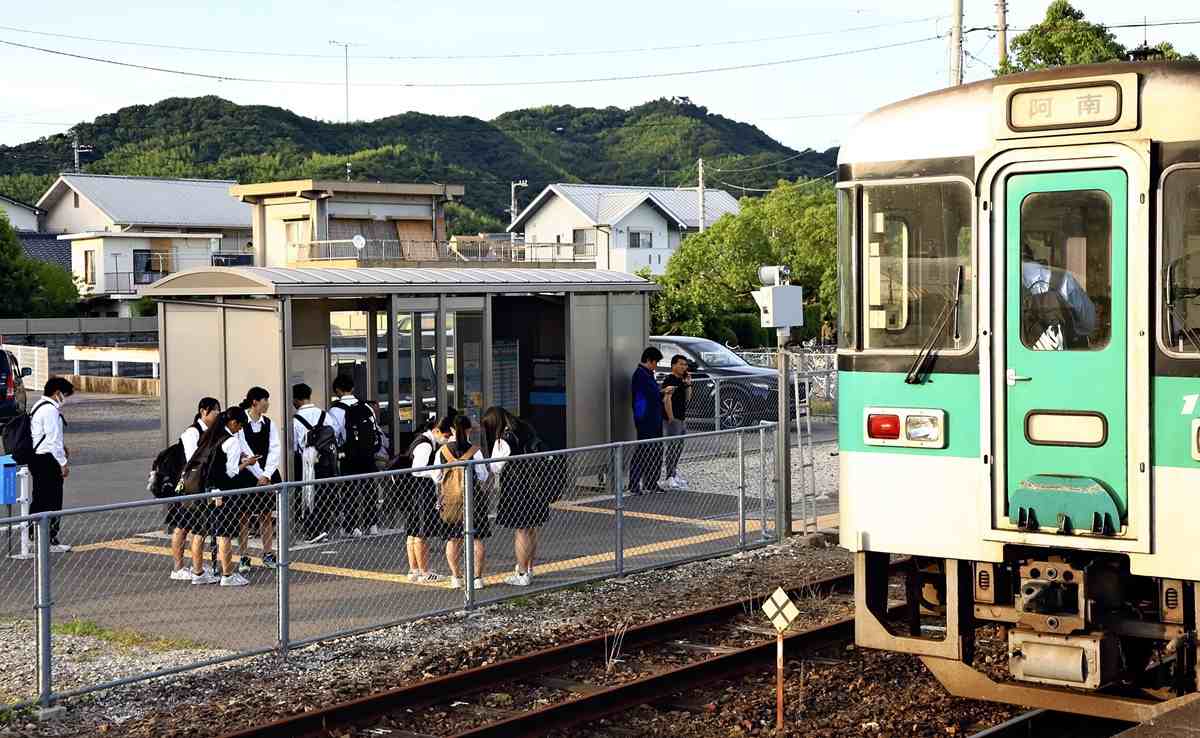Wooden Train Stations in Shikoku Face Demolition; Maintenance Too Costly amid Decreasing Ridership

Students wait for a train at Chuden Station, which is now a simple aluminum structure, in Komatsushima, Tokushima Prefecture.
15:40 JST, July 20, 2024
TOKUSHIMA/KOCHI — Shikoku Railway Co. (JR Shikoku), which has been suffering a long slump in business, is moving ahead with the demolition of its old wooden station buildings and replacing them with simpler ones that look more like bus stops.
Aiming to reduce maintenance costs, the company has already constructed 13 such stations so far. Some residents have voiced opposition to the demolition of the old station buildings, which have served as local landmarks and provided travelers with a sense of being on a journey.

The old Chuden Station building in 2022
In 2022, a station building from 1936 was demolished and replaced with a new aluminum structure at Chuden Station in Komatsushima, Tokushima Prefecture. The station on the Mugi Line now has a space measuring only 10.8 square meters and is equipped with just two benches and a ticket vending machine.
The daily number of passengers using the station was 826 on average last fiscal year, and it is mostly used in the mornings and evenings by students and others commuting to school or work.
An 18-year-old high school girl who uses the station to get to school spoke of the inconvenience of the small station.
“It can’t accommodate all of us on rainy days, so lots of people stand outside with umbrellas while waiting for the train,” she said.

A bench and a ticket vending machine are installed inside the new Chuden Station structure in Komatsushima, Tokushima Prefecture.
JR Shikoku is facing a difficult situation. Railroad transportation revenue peaked at ¥37.065 billion in fiscal 1991 and declined continuously since then, hitting ¥22.334 billion in fiscal 2023. The company has not been profitable since 1987, when the former Japanese National Railways was split and privatized to create it.

The railway has worked to streamline operations by reducing personnel costs, including making 86% of stations unmanned and implementing one-person operation for about 60% of regular trains.
Simplifying station buildings began in fiscal 2014. Large-scale repairs to stations cost several million yen and, furthermore, earthquake-proofing is necessary, which additionally costs over ¥10 million. The company thinks that about 70 stations, or nearly 30% of the total, must be simplified in the future.
Residents oppose move
Because station buildings have served as the “face of the community,” opposition has grown among local residents.
JR Shikoku was planning to simplify Awa-Kamo Station in Higashi-Miyoshi, Tokushima Prefecture, because the station building is aging. The station is known for its Western-style building that has a triangular roof.

Awa-Kamo Station in Higashi-Miyoshi, Tokushima Prefecture, is to be rebuilt.
When the company informed the local government of its intention in January 2022, residents launched a petition drive against the move. They claimed that simplifying the station could make the entryway to the town desolate and lifeless, so they submitted 850 signatures to the town government.
After repeated discussions with JR Shikoku, the local government decided that it would be difficult to keep the station building. JR Shikoku will bear the cost of dismantling it, and the municipality will construct a new wooden station building of about 45 square meters, with restrooms and an interaction space, at a cost of about ¥16 million.
In 2016, the Nishi-Sakawa Station building on the Dosan Line was transferred to the Sakawa town government in Kochi Prefecture from JR Shikoku. The town government spent about ¥16 million to make it earthquake-proof and renovate it. The 100-year-old structure will house a facility to promote the nearby clear Niyodo River basin, known as “Niyodo Blue.”
The station building was used on a poster promoting the JR Group’s “Seishun 18 Ticket,” a pass that allows unlimited rides on regular trains throughout Japan.
“We are glad to keep the station building as a symbol of the community,” a town official said.
Kosuke Miyazaki, a professor at the National Institute of Technology, Kagawa College, said that the simplification of the station building was unavoidable due to JR Shikoku’s financial situation.
“However, if the station building loses its function as a space for people to gather and interact, the area around the station may become desolate. The railroad may fall into a vicious cycle in which people do not use the station any longer.”
Miyazaki is calling on both the municipal government and railway companies to find ways to attract people to the station building.
Related Tags
"Features" POPULAR ARTICLE
-

Sanrio to Open Museum in Yamanashi Pref. Dedicated to Founder, Exhibits Include Hello Kitty, Other Characters
-

Autumn Foliage Surrounds Visitors to Tokyo’s Showa Kinen Park
-

My Daughter No Longer Speaks to Me, But I Want to See Her and My Grandchild
-

Kumamoto: Public Bath Refurbished as Library Where You Can Chat, Take Photos
-

Frozen Vegetables: Demand Rises for Convenient, Tasty Domestic Produce
JN ACCESS RANKING
-

Keidanren Chairman Yoshinobu Tsutsui Visits Kashiwazaki-Kariwa Nuclear Power Plant; Inspects New Emergency Safety System
-

Tokyo Economic Security Forum to Hold Inaugural Meeting Amid Tense Global Environment
-

Imports of Rare Earths from China Facing Delays, May Be Caused by Deterioration of Japan-China Relations
-

University of Tokyo Professor Discusses Japanese Economic Security in Interview Ahead of Forum
-

Japan Pulls out of Vietnam Nuclear Project, Complicating Hanoi’s Power Plans

























